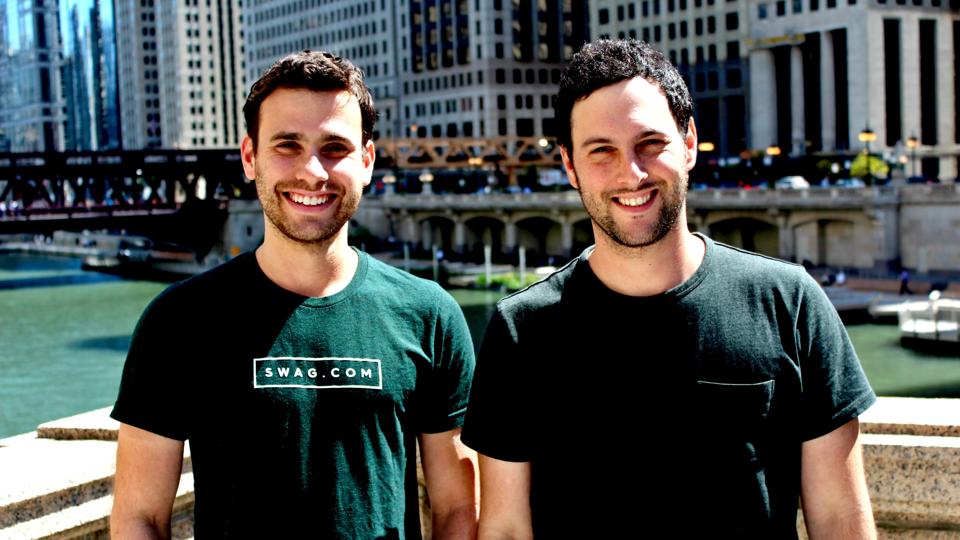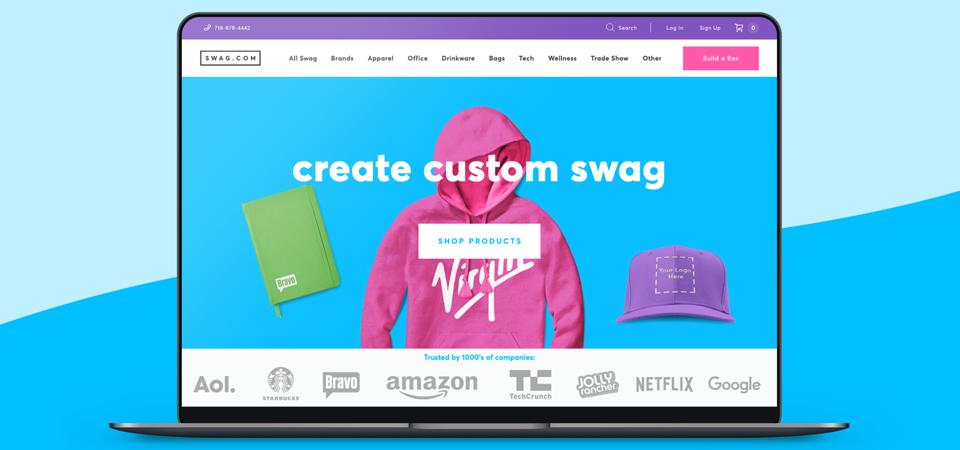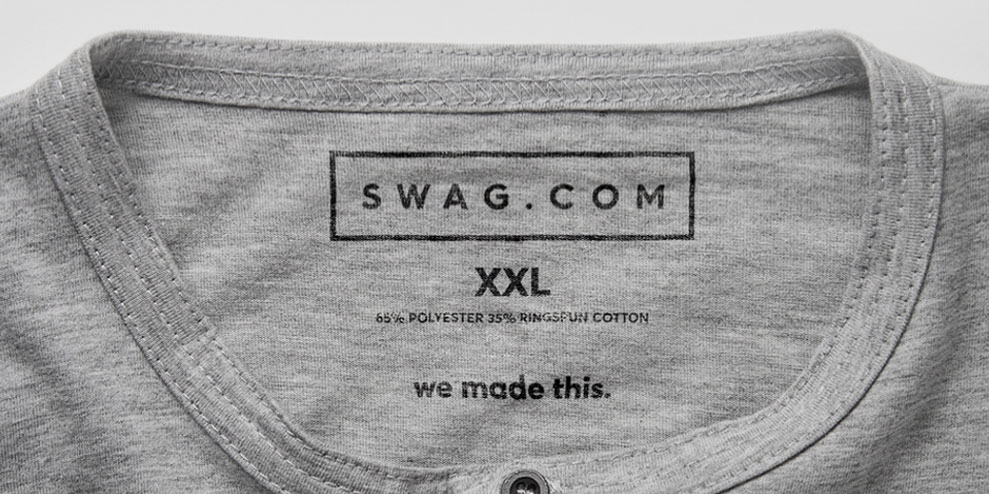Young, hip, digitally native brands love swag – t-shirts, jackets, notebooks, and promotional products with their corporate logo.
So why, Jeremy Parker and Josh Orbach asked back in 2016, isn’t there a young, hip, digitally native way to sell swag to those brands?
That was the a-ha moment that prompted Parker and Orbach to launch Swag.com, a New York-based company that has grown to over $6 million in sales in four years. They expect their sales to double in 2020 to $12 million.
They found a way to enter the highly fragmented and competitive promotional products market by focusing on a basic rule: Don’t call what we sell promotional products, call it swag.
“No young person is calling it promotional products anymore. They’re calling it swag,” Parker said in an interview. With the Swag.com domain name, his company is the first result that appears when someone searches online for the word swag. “We’re getting a lot of people to our site without having to pay for them,” with ads, Parker said.
The word swag has long been used to mean loot, as in something robbers grab. In the promotional business it is said to stand for “stuff we all get” or “souvenirs, wearables, and gifts.” The HBO series Silicon Valley included several memorable moments featuring characters rhapsodizing about the wonders of swag.
Parker says the exact origin of the term is debatable. But one thing is certain, he said. Swag.com is a great domain name. “It has a cool feel to it and it’s insanely memorable.”
The Promotional Products Association International (PPAI) puts the size of the promotional products industry at $28 billion. That includes all the pens, water bottles, mouse pads, phone chargers, tote bags, hats, shirts and other giveaways handed out at trade shows.
But companies, especially startups that want to build their corporate culture, are ordering high-end jackets, backpacks, or electronic devices with their logos as gifts for employees or favored customers.
Swag.com has put company logos on Bellroy backpacks, Sonos speakers, Allbirds sneakers, and even a custom bicycle.
Parker and Orbach decided to target the office managers at startups and tech companies who were looking for better quality, curated items that can be imprinted or embroidered with a logo, rather than thousands of inexpensive throwaway items.
The promotional products industry is highly fragmented, with over 38,000 businesses in the United States, and with no single company having a market share of greater than 5 percent, according to research firm IBISWorld.
The combined revenues of the four largest companies in the industry – 4Imprint Group PLC, Halo Branded Solutions Inc., PFG Ventures LP, and Bensussen Deutsch & Associates LLC – make up less than 12 percent of the 2019 sales, IBISWorld reported. The industry, the IBISWorld report noted, is also characterized by a low level of technological change.
The Swag.com founders believe that gives them an opportunity.
Parker’s first job after college, 12 years ago, was working for a large promotional products company. “I learned the ins and outs of the industry and I saw how old and broken it was,” he said in an interview. “Every sale was done through catalogs, email back and forth, phone calls, very old school.”
The typical buyer of promotional products a decade ago was a 45 to 50 year old office manager, Parker said, and that buyer didn’t mind the old way of doing business.
“Over the last 10 years the industry has not changed, but the buyer has changed,” he said. “The buyer is now a 22 to 25 year old millennial.”
Those buyers, Parker said, don’t want to page through catalogs or place orders by phone. They want to be able to do everything on their laptops or phones, and find promotional products that make them, and their companies look good.
Parker and Orbach’s first move was to acquire the Swag.com domain name. Without that name, Parker said, their plan to reach millennial office managers wouldn’t work. The owner of the name initially wanted over $1 million for it, but Parker and Orbach eventually were able to buy it for $200,000.

Swag.com founders Josh Orbach and Jeremy Parker met in college, at Boston University.
SWAG.COM
Next, they talked to as many millennial office managers as possible to learn how to build the kind of promotional products digital platform they wanted.
Then, they set out to land some big name customers that would attract other digitally native clients.
They staked out the Facebook office in New York until they won a $3,405 order for T-shirts, making Facebook their first customer. Then they visited WeWork, and when asked ‘Who else have you worked with?’, they replied “Facebook,” and won WeWork as their second customer, with an order for $19,548 for WeWork summer camp t-shirts.
Their first year in business they did $365,000 in sales, all done the old-fashioned way, with face-to-face meetings and cold calls to office managers. The second year, 2017, they launched their e-commerce site and did over $1 million in sales. In 2018, Parker said, they did over $3 million in sales and this year Swag.com is on track to double last year’s results, with between $6 and $7 million in sales.
October was the company’s strongest month to date, with over $700,000 in sales, Parker said. The company expects to double sales again next year, to $12 million.
Now, Parker said, potential customers are calling Swag.com, rather than the other way around. “This is the first year we haven’t made one outbound sales call,” he said. “Every single sale has been inbound.”
The company is not yet profitable, Parker said, because it is investing in growth, particularly in tech innovations for its e-commerce platform.
Swag.com has raised $2.8 million in venture capital from investors.

An image of the Swag.com website. The company was founded in 2016 and launched its e-commerce site … [+]
SWAG.COM
Tech innovations the company has invested in include a patent-pending color detection software that matches the colors in customer logos to the corresponding color in the Pantone color identification system. That information then goes to the vendors Swag.com uses to supply the t-shirts, water bottles and other products so they can get the logo colors right.
“It’s very important,” Parker said. “Coca Cola needs to be Coca Cola red. If they go Staples red it would be a problem.”
The company recently launched a “Swag inventory” service that lets businesses who need to keep promotional items on hand for new hires, or employee work anniversaries buy in bulk, and replenish items as needed from Swag.com fulfillment centers.
“We think of Swag Inventory like a online swag closet,” Parker said. “We do all the heavy lifting for them. They no longer need the swag closet.” Swag.com will keep track of what items they have in stock and ship them to offices, or sent them out as customer rewards, as needed, he said.
“Our belief is Swag Inventory is going to be game-changing, by locking customers into a longer order cycle,” he said.
Other promotional products firms offer some of the services found on Swag.com, such as inventory tracking, and “swag in a box” – a boxed collection of company logo items for new employees or clients. Many use the term swag on their home pages to boost search results. But Parker and Orbach have something they don’t have, the Swag.com name.
–
This article first appeared in www.forbes.com
Seeking to build and grow your brand using the force of consumer insight, strategic foresight, creative disruption and technology prowess? Talk to us at +9714 3867728 or mail: info@groupisd.com or visit www.groupisd.com




